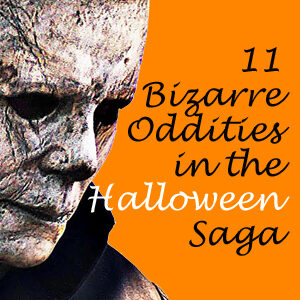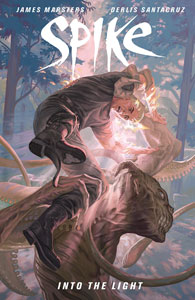Over in the pages of Season 10, things are going well in Buffy and Spike’s relationship, so in true “Buffy” fashion, it’s time to throw a monkey wrench into the mix. It comes in the form of an old flame of Spike’s, who pops up in Issue 21. But who would that old flame be? Drusilla doesn’t work because she and Spike are in decidedly different places in terms of soul-having. His first love is intriguing, because no one gets over their first love, but he actually does get over Cecily (more than a century later) in “Spike: Old Times.” (And he gets immediate revenge on her in the non-canon but excellent “These Our Actors.”)
So the answer is Dylan, but first she has to be introduced in the 66-page hardcover “Spike: Into the Light” (July 2014), set “near the beginning of Season 7.” James Marsters had done good writing of evil-era Spike in the “Spike & Dru” series back in 1999-2000, and he also has a feel for good-era Spike. Derlis Santacruz is a solid artist, and Andy Owens’ inks and Dan Jackson’s colors help this line up with the art in the main “Buffy” series.
The problem with “Into the Light” – produced during a period when Dark Horse was shuffling through editors — is that the continuity doesn’t make sense (at least at first glance). It must take place after Spike has acquired his soul in Africa and is journeying back to Sunnydale. Throughout early Season 7, Spike is psychologically tortured, living in the basement of Sunnydale High, and I’d always assumed it was because he’s dealing with having a soul. “Into the Light” posits that he is level-headed on his trek back to Sunnydale, though. He has problems thanks to this pesky soul, but not from his mind being unhinged.
“Into the Light” is an almost breezy fable where Spike realizes he can’t do the things he used to do — certainly he can’t feed on innocent people, but he also can’t steal. (He could use a new pair of boots, and has no money, but can’t bring himself to nab a pair.) This is partly because of his soul and partly because he is measuring his actions against what Buffy would do. In Greenville (state unspecified, although the Wiki page tells me it’s California), he hits it off with Dylan after saving her from street thugs, but she of course balks and runs off when she sees his vampire face. She hasn’t forgotten him, though, and presumably gets over the vamp-face thing in the meantime (perhaps because vamps are mainstream now), and seeks him out in Season 10 in San Francisco.
“Spike: Into the Light” is arguably a good example of the perils of declaring that a series is canonical, and that previously published spinoff works are not. (Disney’s “Star Wars” is going through this with the continuity errors peppering its new canon, despite its claim that everything fits together on this go-around.) The factors that led to continuity errors with the old stuff don’t go away when producing the canonical stuff. Perhaps because of the editorial shuffle at Dark Horse, “Into the Light” got made without anyone thinking about whether this snugly fits into the timeline.

There is another argument to be made, though: The Wiki page for “Into the Light” contends that – in light of this comic — Spike’s behavior in early Season 7 is now unambiguously influenced by the First Evil, not by him dealing with his new soul. It’s a compelling argument. Angel is a mess after gaining his soul; Harmony doesn’t change at all. Maybe Spike had been on the path to good for long enough – propelled by the non-violence chip and his love for Buffy – that gaining a soul isn’t a cause to be psychologically tortured like it was for Angel. Maybe his situation is closer to Harmony’s: Having or not having a soul doesn’t affect his behavior all that much.
In light of that argument, I’m giving “Into the Light” the benefit of the doubt, even though I’d be surprised to learn that Joss Whedon and the Season 7 writers intended Spike’s struggle to be entirely because of the First Evil’s influence.
Click here for an index of all of John’s “Buffy” and “Angel” reviews.

